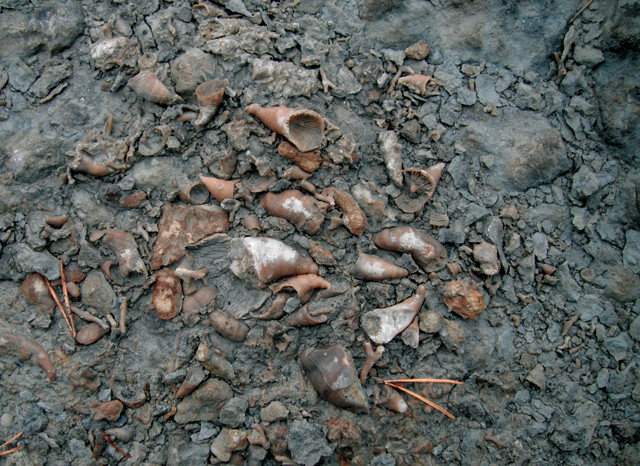
by Bethany Augliere Tuesday, October 16, 2018

Marine organisms like corals, sponges and snails have been migrating for millions of years, mostly driven by temperature changes. Credit: Carl Reddin.
Scientists have suspected that ancient animals migrated in response to changing global temperatures, but until now, there was no documentation of this across extensive time periods. In a new study, researchers found that, for millions of years, marine organisms like corals, sponges and snails, have shifted their ranges in response to climate change.
“Life always tracks its preferred temperature as climate changes,” says Carl Reddin, a paleobiologist at the University of Erlangen-Nürnberg in Germany and lead author of the new study, published in the journal Global Ecology and Biogeography. By analyzing North American and European fossils, Reddin and his colleagues uncovered migration patterns of ancient marine organisms over the last half billion years. The team used a global paleobiological database to analyze the occurrence of hundreds of thousands of fossils. Based on age estimates, fossils were grouped into one of 94 geological ages, which averaged 6.12 million years.
Then, the team filtered the data. For instance, one requirement for their data collection was that the organisms did not go extinct during the time period the study was investigating. Additionally, they identified and grouped animals at the genus level, rather than as individual species. “The main reason we use genera instead of species is because that’s the level of confidence most fossils can be identified to,” Reddin says. Overall, the scientists analyzed 458,000 fossils in 76,000 fossil collections.
Reddin and his team also had to correct for sampling biases. They wanted to analyze where the organisms lived, not where they were found. “Most fossils are found where paleontologists [spend the most time searching], and that has historically meant North America and Europe,” says Matthew Powell, a geologist at Juniata College in Pennsylvania, who was not involved in the study.
To correct for that bias, the scientists averaged the latitude at which fossils were found for all specimens of a given genus, as well as the average of all fossils found. The difference in those two numbers is the latitude the scientists used to analyze migration over time. They tracked only genera that survived across time steps, only from well-fossilized groups such as clams, only at geographic grid cells that were sampled across time steps, and focused on the best sampled hemisphere.
Once the scientists had the corrected latitude coordinates for the fossils, they could find the change in a genus’ location over time. Then they modeled how plate tectonics impacted the animals’ movements and compared the results to the locations of the animals’ current habitats.
Reddin and his team found that organisms had shifted their ranges in response to climate change over the post-Cambrian Phanerozoic Eon. The genera studied moved an average of about 30 centimeters per decade.
Climate change explained 31.4 percent of the migration. This number is higher than what’s been observed in recent studies of marine life range shifts, Reddin says. Other explanations for shifting ranges could involve changes in habitat availability, he adds.
The researchers found that the shifts were stronger among tropical organisms, and weaker among high-latitude organisms, which was surprising because they thought polar organisms would move toward the equator seeking more suitable habitat during cooling episodes. “In some ways we were expecting high-latitude organisms to show this pattern a bit more strongly,” Reddin says.
Looking at the past can help scientists understand the future. Current studies show that marine organisms today are already shifting their ranges based on changing temperatures. What that means for future ecosystems and the potential risks to humans is unknown, Reddin says. “That was the overall motivation for looking at this question, given the climate warming we are experiencing at the moment,” he says.
“I’m excited by this paper,” Powell says. “This study enables us to use the fossil record to start answering some questions about how organisms have responded to climate change in the past.” Powell says he hopes more studies like this will follow. In the fossil record, “we have not really been able to explore changes in geographic ranges of taxa,” he says. “It’s really only been treated at the global scale.”
© 2008-2021. All rights reserved. Any copying, redistribution or retransmission of any of the contents of this service without the expressed written permission of the American Geosciences Institute is expressly prohibited. Click here for all copyright requests.